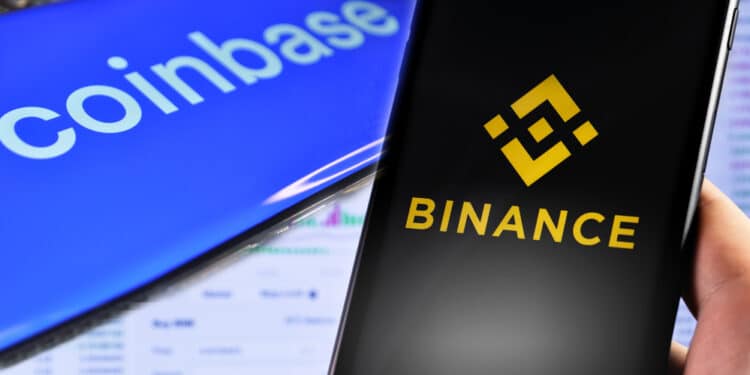It’s all the rage these days to make money with cryptocurrency. However, with so many platforms to choose from, it may be tough to choose one that you can rely on. Coinbase and Binance, in particular, have been extremely popular in recent years. While Coinbase is one of the oldest and most well-known cryptocurrency exchanges, Binance has grown to become the largest cryptocurrency exchange in recent years. It’s vital to note that Binance has a separate site named Binance.US for US investors. Also, Coinbase is split into two platforms: Coinbase and Coinbase Pro.
What is Binance?

Binance was created in 2017 and is located in Malta, a European Union country. The website for the United States, Binance.US features fewer coins and trading choices than on the main website. Furthermore, Binance.US isn’t available in every state. Binance is unique in that it is both a cryptocurrency exchange and has its own token, Binance Coin (BNB). Investors and traders can utilize BNB to conduct transactions on Binance and save money on trading fees as a result.
Binance offers complex trading tactics and powerful charting tools, allowing you to get involved with more advanced trading approaches. There’s also an over-the-counter option that lets you trade with other users directly and perhaps cut deals.
What is Coinbase?

Coinbase is a cryptocurrency exchange situated in San Francisco that was started in 2012. It’s a publicly-traded company that trades under the ticker COIN on the NASDAQ platform. There are various supported trading pairs, so you don’t have to convert your tokens to fiat cash every time you want to buy something else.
You may earn tokens by learning about numerous altcoins, allowing you to diversify your holdings. Registrants can also sign up for a waitlist for Coinbase’s credit card, which is expected to arrive soon. You can also sign up for Coinbase Pro, which offers more advanced trading options and access to a variety of order types.
Binance vs. Coinbase
Available cryptos
Both Coinbase and Binance allow customers to acquire crypto using fiat currencies such as the US dollar and pound sterling. Their service offerings, on the other hand, are quite distinct, beginning with the number of cryptos offered on each platform.
Binance offers approximately 500 cryptocurrencies, whereas Binance US offers over 60 different forms of digital assets. Over 150 coins are available on Coinbase and Coinbase Pro. Binance outperforms Coinbase in terms of top ten coins by market capitalization, offering eight of the top ten coins versus Coinbase’s seven. Of course, both offer Bitcoin; the main difference is that Binance also offers BNB, the coin that powers the Binance ecosystem.
Fees
For transactions under $50,000, Binance charges a 0.10% transaction fee via the maker/taker method. This fee reduces inversely in relation to the order value. Transferring fiat from a bank account is free; however, when using a debit card, the platform levies a fee equivalent to 1.8% of the trade value on the main exchange and 4.5% on Binance.
For transactions under $200, Coinbase charges a flat fee ranging from $0.99 to $2.99. A 0.5% transaction fee (for transactions up to $10,000) plus a convenience charge is applied to order sums above that. The convenience fees vary based on the payment method. Credit card transactions are 3.99%, Coinbase wallet or bank account purchases are 1.49%, and wire deposits and withdrawals are $10 and $25, respectively.
Mobile apps
They both have a mobile app available on the Playstore and AppStore. Binance has received almost fifty million downloads, whereas Coinbase has received over ten million.
The Binance app is fast and has a strong aesthetic appeal that gives users confidence in the platform. Binance lite and Binance Pro are the two modes available. Binance Pro includes more advanced features such as charts, indicators, and more.
There are two Coinbase apps. The first app is straightforward and simple to use, making it ideal for both new and experienced investors. The second app, Coinbase Pro, on the other hand, is more likely to be useful for crypto traders. It has everything an active trader needs, including powerful tools, in-depth charts, and accurate market data.
Customer support
Customer service at crypto exchanges is crucial, especially if you’re just getting started with trading. Coinbase’s efforts in this area have recently expanded, with the addition of phone support, a much-needed addition to the previous options of email and a support ticket. Furthermore, if you notice questionable activity, you can contact customer service to have your account locked, which is why this function is necessary.
Unfortunately, Binance does not provide phone support; instead, it only provides support through tickets, which may not be as fast; thus, one can lose cash in the process.
Security and regulation
Coinbase is far more open about the safeguards it employs to protect funds. It claims to keep 98% of assets offline in cold storage, to have third-party insurance in the event of a hack, and take a variety of other precautions. Binance may have solid security procedures in place as well, but this information isn’t readily apparent on its website. Both Binance and Binance.US provide a lot of information about how customers may protect their accounts, but they don’t provide any information about how they secure assets held on the exchange.
Binance is trying hard to regain the trust of regulators. It has a reputation as a transaction that takes action without first seeking permission. Coinbase, on the other hand, has done a good job of staying out of the way of regulatory scrutiny.
Summary
Which platform is better to start crypto trading? Binance gets the win. This is due to the low trading fees, a large number of cryptos available, and the app’s flawless user experience and aesthetic appeal. Coinbase, on the other hand, offers enhanced security features as well as dependable customer service, which is beneficial to beginning traders. However, the user must select the exchange that best suits his or her needs.




